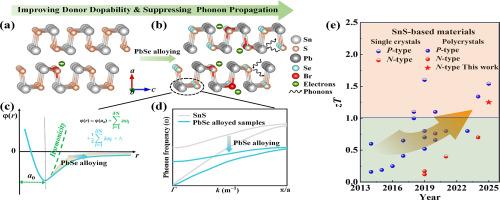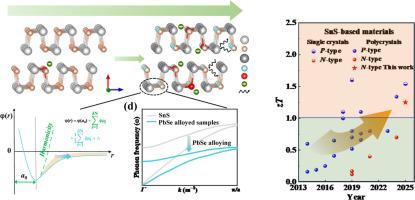Achieving superior thermoelectric performance in N-type SnS-based polycrystals by regulating donor dopability and phonon propagation
IF 9.3
1区 材料科学
Q1 MATERIALS SCIENCE, MULTIDISCIPLINARY
引用次数: 0
Abstract
Recent advancements in p-type SnS-based compounds have highlighted their potential for thermoelectric applications. Nevertheless, the thermoelectric properties of their n-type counterparts lag behind and have been seldom investigated to date, primarily owing to intrinsic Sn vacancies and limited donor dopability, which largely hinders the development of all SnS-based thermoelectric modules. Here, an effective doping strategy is proposed in n-type SnS-based polycrystals by incorporating PbSe along with a donor Br dopant. The electron concentration and power factor of PbSe alloyed compounds outperforms that of the matrix sample, being primarily credited to the improved dopability of Br dopant arising from the lower formation energy of Br dopant in the alloyed samples, as verified by first-principles calculations. Furthermore, the incorporation of PbSe remarkably diminishes the lattice thermal conductivity of the SnS-based materials, resulting from depressed phonon velocity, strengthened lattice anharmonicity and introduction of massive point defects. Consequently, an outstanding maximum zT value of ∼1.25 at 873 K, along with a decent average zT of ∼0.45 from 323 K to 873 K is attained in n-type 2.5 %PbBr2-doped (SnS)0.6(PbSe)0.4 polycrystalline sample, representing record-high values in n-type SnS-based compounds. This research not only reveals that the optimal n-type SnS-based polycrystals are promising candidates for thermoelectric applications, but also offers insights into overcoming the doping bottleneck in thermoelectric materials.


通过调节供体可调谐性和声子传播实现n型sns多晶优越的热电性能
近年来p型sns化合物的进展突出了它们在热电应用方面的潜力。然而,它们的n型对应物的热电性能落后,迄今为止很少进行研究,主要是由于固有的Sn空位和有限的供体相容性,这在很大程度上阻碍了所有基于Sn的热电模块的发展。本文提出了一种有效的掺杂策略,即在n型sn基多晶中掺入PbSe和供体Br掺杂剂。PbSe合金化合物的电子浓度和功率因数优于基体样品,这主要归功于合金样品中Br掺杂物的形成能较低,从而提高了Br掺杂物的可掺杂性,第一性原理计算证实了这一点。此外,PbSe的掺入显著降低了sns基材料的晶格热导率,导致声子速度降低,晶格非调和性增强以及大量点缺陷的引入。因此,在873 K时,在n型2.5% pbbr2掺杂(SnS)0.6(PbSe)0.4多晶样品中获得了显著的zT最大值~ 1.25,以及从323 K到873 K的可观的平均zT值~ 0.45,代表了n型sn基化合物中创纪录的高值。本研究不仅揭示了最佳的n型sn基多晶是热电应用的有希望的候选材料,而且为克服热电材料的掺杂瓶颈提供了见解。
本文章由计算机程序翻译,如有差异,请以英文原文为准。
求助全文
约1分钟内获得全文
求助全文
来源期刊

Acta Materialia
工程技术-材料科学:综合
CiteScore
16.10
自引率
8.50%
发文量
801
审稿时长
53 days
期刊介绍:
Acta Materialia serves as a platform for publishing full-length, original papers and commissioned overviews that contribute to a profound understanding of the correlation between the processing, structure, and properties of inorganic materials. The journal seeks papers with high impact potential or those that significantly propel the field forward. The scope includes the atomic and molecular arrangements, chemical and electronic structures, and microstructure of materials, focusing on their mechanical or functional behavior across all length scales, including nanostructures.
 求助内容:
求助内容: 应助结果提醒方式:
应助结果提醒方式:


